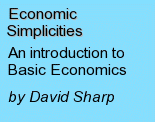




Introduction to Economics Lesson 02 / 08
Subprime Mortgages
The term Subprime [or Sub-prime] Mortgages has appeared frequently in the last two years with reference to the current worldwide economic instability. What is a Subprime Mortgage and what, if any, is its connection to the present economic situation ? Is the affect of such loans significant and if so how and why ?
What is a Subprime Mortgage ?
A Mortgage is a loan secured by property, particularly real estate. The term mortgage is also used to refer to the legal instrument, which provides proof of, and security for, the loan. In the event of default it enables the lender to have recourse against the property.
A Subprime Mortgage is a
mortgage loan made to a borrower whose credit rating does not otherwise
qualify him or her for a conventional loan.
People who have been bankrupt, who have a credit history of late
or missed payments or who have, for whatever reason, no credit history
at all, can have difficulty in obtaining a conventional mortgage.
There is perceived to be a greater risk of default.
Lenders have, at least in recent years, been prepared to offer such people a variety of borrowing options in lieu of a conventional mortgage, and which have collectively been referred to as Subprime Mortgages. Typically they are short term, high interest, variable rate loans. Often they include a short period [2-3 years] of nil or low fixed interest, and then an interest rate adjustable to market.
How & Why
-
Low and declining interest rates and an easy money policy implemented by the US Federal Reserve 2001- 2003 helped not only to sustain the stock market but also to create a speculative housing bubble, said by “The Economist” to be the biggest in history.
-
Between 1997 and 2006 average house prices in the USA increased 124%.
-
Government-guaranteed mortgage lenders originated large numbers of mortgages and then securitised them, that is to say the mortgages were packaged up and sold to investment banks and funds throughout the world, at their nominal face value. Securitisation is a relatively recent invention, providing an investment vehicle for the cheap easy money the government had provided. The lending banks and institutions were thus relieved of primary responsibility for the ongoing viability of the loan. Virtually anyone could obtain a housing loan. The nominal value of securities thus created and sold is said to have totaled tens of trillions of US dollars, far exceeding the value of US issued dollar currency.
-
While house prices continued to rise everything was fine. The securitised packages of US mortgages were marketed as safe investments paying good returns. Mortgage borrowers who got into trouble could generally refinance from eager lenders, or the properties themselves could be ‘flipped’, that is resold at a profit. With relatively few foreclosures, lending banks could avoid any direct attributable loss to their mortgages by buying the foreclosed property themselves at a price sufficient to cover whatever was owed, and thereafter absorbing any loss involved.
-
The ability to package and sell the mortgages at their face value meant lending banks and brokers tended not to scrutinize carefully the flipped price on a resale, in order to write the new mortgage, or even to conspire in accepting an unreal inflated price.
-
In order to curb the ever more apparent excesses a few minor regulatory changes were made by the government on 7 July 2006 designed to control flipping. This led to a small decline in the number of purchasers and is said by some to have been the trigger for what is referred to as the Subprime Crisis.
-
American property prices began to decline in late 2006. Foreclosures increased and lenders were unable to disguise the losses. Increasing numbers of foreclosures increased the downward pressure on prices leading to more foreclosures.
-
As foreclosures increased in number the mortgage guarantors were unable to cope and began to fail. The value of the securitised mortgage packages became questionable.
-
The fall in property prices coincided with the time when the first of the Adjustable Rate Mortgages with the 2-3 year low or no interest payments were about to switch to market interest rates. Unable to flip or refinance, this further increased the downward pressure on the market.
-
Banks and investment houses worldwide were caught holding large amounts of securitised American mortgages, the value of which, if any, became ever more questionable. Estimates of the losses were of hundreds of billions of US dollars, but with suggestions that they could be much more.
David Sharp